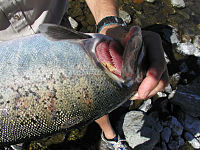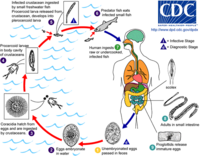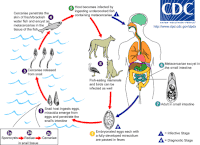Fish diseases and parasites
Like humans and other animals,
Specific defences are specialised responses to particular pathogens recognised by the fish's body, that is
Some commercially important fish diseases are
Parasites
Usually parasites (and pathogens) need to avoid killing their hosts, since extinct hosts can mean extinct parasites. Evolutionary constraints may operate so parasites avoid killing their hosts, or the natural variability in host defensive strategies may suffice to keep host populations viable.
However, not all parasites want to keep their hosts alive, and there are parasites with multistage life cycles who go to some trouble to kill their host. For example, some tapeworms make some fish behave in such a way that a predatory bird can catch it. The predatory bird is the next host for the parasite in the next stage of its life cycle.[12] Specifically, the tapeworm Schistocephalus solidus turns infected threespine stickleback white, and then makes them more buoyant so that they splash along at the surface of the water, becoming easy to see and easy to catch for a passing bird.[13]
Parasites can be internal (
Fish gills are also the preferred habitat of many external parasites, attached to the gill but living out of it. The most common are
Other parasitic disorders, include
Although parasites are generally considered to be harmful, the eradication of all parasites would not necessarily be beneficial. Parasites account for as much as or more than half of life's diversity; they perform an important ecological role (by weakening prey) that ecosystems would take some time to adapt to; and without parasites organisms may eventually tend to asexual reproduction, diminishing the diversity of sexually dimorphic traits.[23] Parasites provide an opportunity for the transfer of genetic material between species. On rare, but significant, occasions this may facilitate evolutionary changes that would not otherwise occur, or that would otherwise take even longer.[24]
Below are some life cycles of fish parasites:
-
Life cycle of theendoparasite Ichthyophthirius multifiliis, commonly called ich
-
Life cycle of theyellow grub
-
Life cycle of the digenean Bucephalus polymorphus
-
Life cycle of theparasitic nematode Huffmanela huffmani[25]
Cleaner fish
Some fish take advantage of cleaner fish for the removal of external parasites. The best known of these are the bluestreak cleaner wrasses of the genus Labroides found on coral reefs in the Indian Ocean and Pacific Ocean. These small fish maintain so-called "cleaning stations" where other fish, known as hosts, will congregate and perform specific movements to attract the attention of the cleaner fish.[26] Cleaning behaviours have been observed in a number of other fish groups, including an interesting case between two cichlids of the same genus, Etroplus maculatus, the cleaner fish, and the much larger Etroplus suratensis, the host.[27]
More than 40 species of
Mass die offs

Some diseases result in mass die offs.
Wild salmon
According to Canadian biologist Dorothy Kieser, protozoan parasite
Henneguya and other parasites in the myxosporean group have a complex lifecycle where the salmon is one of two hosts. The fish releases the spores after spawning. In the Henneguya case, the spores enter a second host, most likely an invertebrate, in the spawning stream. When juvenile salmon out-migrate to the Pacific Ocean, the second host releases a stage infective to salmon. The parasite is then carried in the salmon until the next spawning cycle. The myxosporean parasite that causes whirling disease in trout, has a similar lifecycle.[35] However, as opposed to whirling disease, the Henneguya infestation does not appear to cause disease in the host salmon — even heavily infected fish tend to return to spawn successfully.
According to Dr. Kieser, a lot of work on Henneguya salminicola was done by scientists at the Pacific Biological Station in Nanaimo in the mid-1980s, in particular, an overview report[36] which states that "the fish that have the longest fresh water residence time as juveniles have the most noticeable infections. Hence in order of prevalence coho are most infected followed by sockeye, chinook, chum and pink." As well, the report says that, at the time the studies were conducted, stocks from the middle and upper reaches of large river systems in British Columbia such as Fraser, Skeena, Nass and from mainland coastal streams in the southern half of B.C. "are more likely to have a low prevalence of infection." The report also states "It should be stressed that Henneguya, economically deleterious though it is, is harmless from the view of public health. It is strictly a fish parasite that cannot live in or affect warm blooded animals, including man".
According to Klaus Schallie, Molluscan Shellfish Program Specialist with the Canadian Food Inspection Agency, "Henneguya salminicola is found in southern B.C. also and in all species of salmon. I have previously examined smoked chum salmon sides that were riddled with cysts and some sockeye runs in Barkley Sound (southern B.C., west coast of Vancouver Island) are noted for their high incidence of infestation."
Farmed salmon

In 1972, Gyrodactylus salaris, also called salmon fluke, a monogenean parasite, spread from Norwegian hatcheries to wild salmon, and devastated some wild salmon populations.[45]
In 1984,
In the wild, diseases and parasites are normally at low levels, and kept in check by natural predation on weakened individuals. In crowded net pens they can become epidemics. Diseases and parasites also transfer from farmed to wild salmon populations. A recent study in
-
furunculosisin marine and freshwater fish.
-
Streptococcus iniae, a Gram-positive, sphere-shaped bacteria caused losses in farmed marine and freshwater finfish of US$100 million in 1997.[51]
-
Myxobolus cerebralis, a myxosporean parasite, causes whirling disease in farmed salmon and trout and also in wild fish populations.
-
on the Pacific coast of North America.
Coral reef fish
Aquarium fish

In most
Due to their generally small size and the low cost of replacing diseased or dead aquarium fish, the cost of testing and treating diseases is often seen as more trouble than the value of the fish.
-
dropsy
-
Columnaris in the gill of a chinook salmon
-
The parasite Henneguya zschokkei in salmon beard
-
Skin ulcers inPfiesteria shumwayae
Immune system
Immune organs vary by type of fish.
Like chondrostean fish, the major immune tissues of bony fish (or
Spreading disease and parasites
The capture, transportation and culture of bait fish can spread damaging organisms between ecosystems, endangering them. In 2007, several American states, including Michigan, enacted regulations designed to slow the spread of fish diseases, including viral hemorrhagic septicemia, by bait fish.[61] Because of the risk of transmitting Myxobolus cerebralis (whirling disease), trout and salmon should not be used as bait. Anglers may increase the possibility of contamination by emptying bait buckets into fishing venues and collecting or using bait improperly. The transportation of fish from one location to another can break the law and cause the introduction of fish and parasites alien to the ecosystem.
Eating raw fish
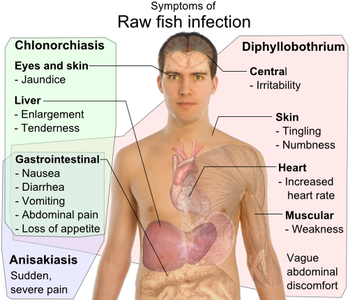
Though not a health concern in thoroughly cooked fish, parasites are a concern when human consumers eat raw or lightly preserved fish such as sashimi, sushi, ceviche, and gravlax. The popularity of such raw fish dishes makes it important for consumers to be aware of this risk. Raw fish should be frozen to an internal temperature of −20 °C (−4 °F) for at least seven days to kill parasites. It is important to be aware that home freezers may not be cold enough to kill parasites.[67][68]
Traditionally, fish that live all or part of their lives in
There are three main kinds of parasites:
Below are some life cycles of fish parasites that can infect humans:
-
Life cycle of the liver fluke Clonorchis sinensis
-
Life cycle of the parasitic Anisakis worm
-
Life cycle of the fish tapewormDiphyllobothrium latum
-
Life cycle of the digenean Metagonimus, an intestinal fluke
See also
- Bath treatment (fishkeeping)
- Cyanotoxin
- Diseases and parasites in cod
- European Community Reference Laboratory for Fish Diseases
- Fish farming
- Fish kill
- Fish toxins
- Fish medicine
- List of aquarium diseases
- Mathematical modelling of infectious disease
- Red tide
- Veterinary parasitology
Citations
- ^ Disease Factsheets: Viral Hemorrhagic Septicemia Iowa State University, The Center for Food Security & Public Health. Last updated 17 May 2007. Retrieved on 2007-07-12.
- ^
Lom J, Dyková I (2005). "Microsporidian xenomas in fish seen in wider perspective". Folia Parasitologica. 52 (1–2): 69–81. PMID 16004366.
- ISBN 0-86542-256-7
- ^ Rao, S, Byadgi, O, Pulpipat, T, Wang, P-C, Chen, S-C. Efficacy of a formalin-inactivated Lactococcus garvieae vaccine in farmed grey mullet (Mugil cephalus). J Fish Dis. 2020; 43: 1579– 1589. https://doi.org/10.1111/jfd.13260
- ^ Cipriano RC (2001) "Furunculosis And Other Diseases Caused By Aeromonas salmonicida" Archived 2009-05-07 at the Wayback Machine Fish Disease Leaflet 66, US Department of the Interior.
- ^ Hartman KH et al. (2004) "Koi Herpes Virus (KHV) Disease". Fact Sheet VM-149. University of Florida Institute of Food and Agricultural Sciences.
- JSTOR 1444352.
- The Merck Veterinary Manual. Archived from the originalon 3 March 2016. Retrieved 4 November 2019.
- ^ Zabel, N.; Swanson, Heidi; Conboy, G. (March 2023). Guide to Common Parasites of Food Fish Species in the Northwest Territories and Nunavut. Global Water Futures Northern Water Futures.
- ^ Moyle and Cech, 2004, page 615
- ]
- .
- S2CID 40173189.
- PMID 24836940.

- ^ Pozdnyakov, S. E. & Gibson, D. I. (2008). Family Didymozoidae Monticelli, 1888. In R. A. Bray, D. I. Gibson & A. Jones (Eds.), Keys to the Trematoda, Vol. 3 (pp. 631-734). London: CAB International and The Natural History Museum.
- S2CID 29105973.
- .
- ^ Kearn, G. C. (2004). Leeches, Lice and Lampreys. A natural history of skin and gill parasites of fishes. Dordrecht: Springer.
- .
- ISBN 978-81-315-0104-7.)
{{cite book}}: CS1 maint: multiple names: authors list (link - ^ Shields, Jeffrey. "Epicaridea: The parasitic isopods of Crustacea". Virginia Institute of Marine Science. Archived from the original on 5 January 2019. Retrieved 23 March 2014.
- JSTOR 1444352.
- .
- ^ Claude Combes, The Art of being a Parasite, U. of Chicago Press, 2005
- PMID 27312028.

- ISBN 0-86542-256-7
- JSTOR 1442742.
- ^ Thys, Tierney. "Molidae Descriptions and Life History". OceanSunfish.org. Retrieved 8 May 2007.
- ^ M. McGrouther (November 2004). "Ocean Sunfish Stranding". Australian Museum Online. Retrieved 11 May 2007.
- ^ "Mola (Sunfish)". National Geographic. Archived from the original on 14 November 2006. Retrieved 8 May 2007.
- ^ Thys, Tierney. "Molidae information and research". OceanSunfish.org. Retrieved 11 May 2007.
- ^ Moyle and Cech, 2004, page 466
- ^ a b Burkholder JM, Glasgow HB and Hobbs CW (1995) "Fish kills linked to a toxic ambush-predator dinoflagellate: distribution and environmental conditions" Marine Ecology Progress Series.
- .
- ^ Crosier, Danielle M.; Molloy, Daniel P.; Bartholomew, Jerri. "Whirling Disease – Myxobolus cerebralis" (PDF). Archived from the original (PDF) on 16 February 2008. Retrieved 13 December 2007.
- ^ N.P. Boyce; Z. Kabata; L. Margolis (1985). "Investigation of the Distribution, Detection, and Biology of Henneguya salminicola (Protozoa, Myxozoa), a Parasite of the Flesh of Pacific Salmon". Canadian Technical Report of Fisheries and Aquatic Sciences (1450): 55.
- ^ Sea Lice and Salmon: Elevating the dialogue on the farmed-wild salmon story Archived 14 December 2010 at the Wayback Machine Watershed Watch Salmon Society, 2004.
- ^ Bravo, S. (2003). "Sea lice in Chilean salmon farms". Bull. Eur. Assoc. Fish Pathol. 23, 197–200.
- doi:10.1139/f04-016.
- ^ Peet, C. R. 2007. Thesis, University of Victoria.
- PMID 17939989.
- .
- PMID 17021017.
- ^ Krkošek, Martin, et al. Report: "Declining Wild Salmon Populations in Relation to Parasites from Farm Salmon", Science: Vol. 318. no. 5857, pp. 1772 - 1775, 14 December 2007.
- ISBN 978-1-85233-119-1
- ^ New Brunswick to help Chile beat disease Fish Information and Services
- ^ Fact Sheet - Atlantic Salmon Aquaculture Research Archived 29 December 2010 at the Wayback Machine Fisheries and Oceans Canada. Retrieved 12 May 2009.
- ^ Seafood Choices Alliance (2005) It's all about salmon Archived 2015-09-24 at the Wayback Machine
- ^ Scientific Evidence Archived 19 September 2006 at the Wayback Machine.
- ^ Krkosek M, Ford JS, Morton A, Lele S, Myers RA and Lewis MA (2007) Declining Wild Salmon Populations in Relation to Parasites from Farm Salmon Science, 318, 5857: 1772.
- PMID 17418985.
- ^ PMID 22947621.

- ^
- ^ a b c Justine, J.-L., Beveridge, I., Boxshall, G. A., Bray, R. A., Moravec, F. & Whittington, I. D. 2010: An annotated list of fish parasites (Copepoda, Monogenea, Digenea, Cestoda and Nematoda) collected from Emperors and Emperor Bream (Lethrinidae) in New Caledonia further highlights parasite biodiversity estimates on coral reef fish. Zootaxa, 2691, 1-40. Free PDF

- ^ Justine, J.-L. 2010: Parasites of coral reef fish: how much do we know? With a bibliography of fish parasites in New Caledonia. Belgian Journal of Zoology, 140 (Suppl.), 155-190. Free PDF Archived 2016-03-07 at the Wayback Machine

- ^ A.G. Zapata, A. Chiba and A. Vara. Cells and tissues of the immune system of fish. In: The Fish Immune System: Organism, Pathogen and Environment. Fish Immunology Series. (eds. G. Iwama and T.Nakanishi,), New York, Academic Press, 1996, pp. 1–55.
- ^ D.P. Anderson. Fish Immunology. (S.F. Snieszko and H.R. Axelrod, eds), Hong Kong: TFH Publications, Inc. Ltd., 1977.
- .
- S2CID 7965762.
- S2CID 428224.
- ^ DNR Fishing Regulation Changes Reflect Disease Management Concerns with VHS
- ^ WaiSays: About Consuming Raw Fish Retrieved on April 14, 2009
- ^ For Chlonorchiasis: Public Health Agency of Canada > Clonorchis sinensis - Material Safety Data Sheets (MSDS) Retrieved on April 14, 2009
- ^ For Anisakiasis: WrongDiagnosis: Symptoms of Anisakiasis Retrieved on April 14, 2009
- ^ For Diphyllobothrium: MedlinePlus > Diphyllobothriasis Updated by: Arnold L. Lentnek, MD. Retrieved on April 14, 2009
- ^ For symptoms of diphyllobothrium due to vitamin B12-deficiency University of Maryland Medical Center > Megaloblastic (Pernicious) Anemia Retrieved on April 14, 2009
- ^ Parasites in Marine Fishes University of California Food Science & Technology Department Sea Grant Extension Program Archived 2011-09-27 at the Wayback Machine
- ^ Vaughn M. Sushi and Sashimi Safety
- PMID 2761015.
- PMID 32189441.
- ^ U.S. National Library of Medicine, Medline Plus, "Fish Tapeworm," [1].
General and cited references
- Fish Diseases (2017) Edited By Takashi Aoki, UNESCO-EOLSS Publishers.ISBN 9781780210407
- Axelrod HR, Untergasser D (1989). Handbook of fish diseases. Neptune, NJ: T.F.H. Publications. ISBN 978-0-86622-703-2.
- Andrews C (1988). The Manual of Fish Health. Stillwater, MN: Voyageur Press. ISBN 978-1-56465-160-0.
- Exell A, Burgess PH, Bailey MT (29 May 1999). A-Z of Tropical Fish Diseases and Health Problems. New York, N.Y: Howell Book House. ISBN 978-1-58245-049-0.
- Fairfield, T (2000). A commonsense guide to fish health. Woodbury, N.Y: Barron's Educational Series. ISBN 978-0-7641-1338-3.
- U.S. Food and Drug Administration (FDA) (2001) Compliance Regulatory Information: Fish and Fisheries Products Hazards and Controls GuidanceThird edition.
- ISBN 9780643099272.
- Moyle, PB and Cech, JJ (2004) Fishes, An Introduction to Ichthyology. 5th Ed, Benjamin Cummings. ISBN 978-0-13-100847-2
- Woo PTK (1995) Fish Diseases and Disorders: Volume 1: Protozoan and Metazoan Infections Cabi Series. ISBN 9780851988238.
- Woo PTK (2011) Fish Diseases and Disorders: Volume 2: Non-Infectious Disorders Cabi Series. ISBN 9781845935535.
- Woo PTK (2011) Fish Diseases and Disorders: Volume 3: Viral, Bacterial and Fungal Infections Cabi Series. ISBN 9781845935542.
Further reading
- Sea Lice and Salmon: Elevating the dialogue on the farmed-wild salmon story Watershed Watch Salmon Society, 2004.
- Krkoek, Martin; et al. (2007). "Declining Wild Salmon Populations in Relation to Parasites from Farm Salmon". Science. 318 (5857): 1772–1775. S2CID 86544687.
External links
- Help with Stress & Disease
- The European Union puts in place a framework of measures to combat certain fish diseases effectively and to prevent their spread. Archived 4 February 2012 at the Wayback Machine
- Watershed Watch Salmon Society A British Columbia advocacy group for wild salmon
- Wild Salmon in Trouble: The Link Between Farmed Salmon, Sea Lice and Wild Salmon - Watershed Watch Salmon Society. Animated short video based on peer-reviewed scientific research, with subject background article Watching out for Wild Salmon.
- Aquacultural Revolution: The scientific case for changing salmon farming - Watershed Watch Salmon Society. Short video documentary. Prominent scientists and First Nation representatives speak their minds about the salmon farming industry and the effects of sea lice infestations on wild salmon populations.
- Sea Lice Coastal Alliance for Aquaculture Reform. An overview of farmed- to wild-salmon interactive effects.
- Salmon Farming Problems Coastal Alliance for Aquaculture Reform. An overview of environmental impacts of salmon farming.
- Fish farms drive wild salmon populations toward extinction Biology News Net. 13 December 2007.
- Salmonid parasites University of St Andrews Marine Ecology Research Group.
- FishPEST - Fish Parasite Ecology Software Tool




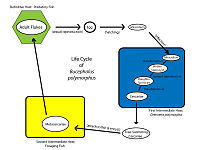
![Life cycle of the parasitic nematode Huffmanela huffmani[25]](http://upload.wikimedia.org/wikipedia/commons/thumb/d/d5/Life_cycle_of_Huffmanela_huffmani_Moravec%2C_1987.png/200px-Life_cycle_of_Huffmanela_huffmani_Moravec%2C_1987.png)

![Streptococcus iniae, a Gram-positive, sphere-shaped bacteria caused losses in farmed marine and freshwater finfish of US$100 million in 1997.[51]](http://upload.wikimedia.org/wikipedia/commons/thumb/3/3f/Streptococcus_iniae.png/200px-Streptococcus_iniae.png)




